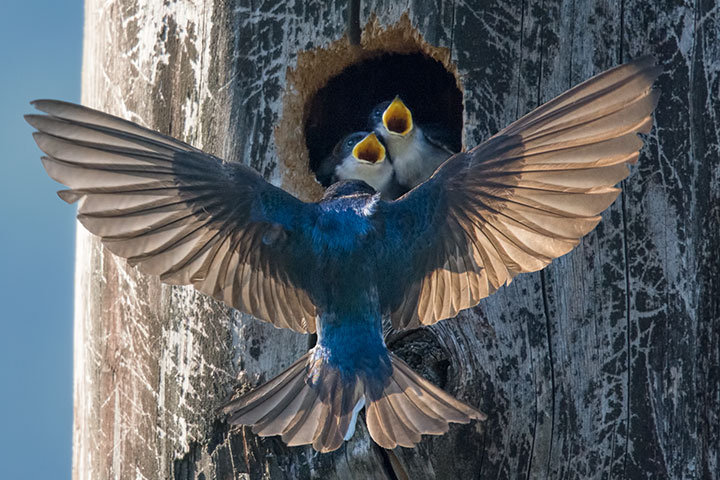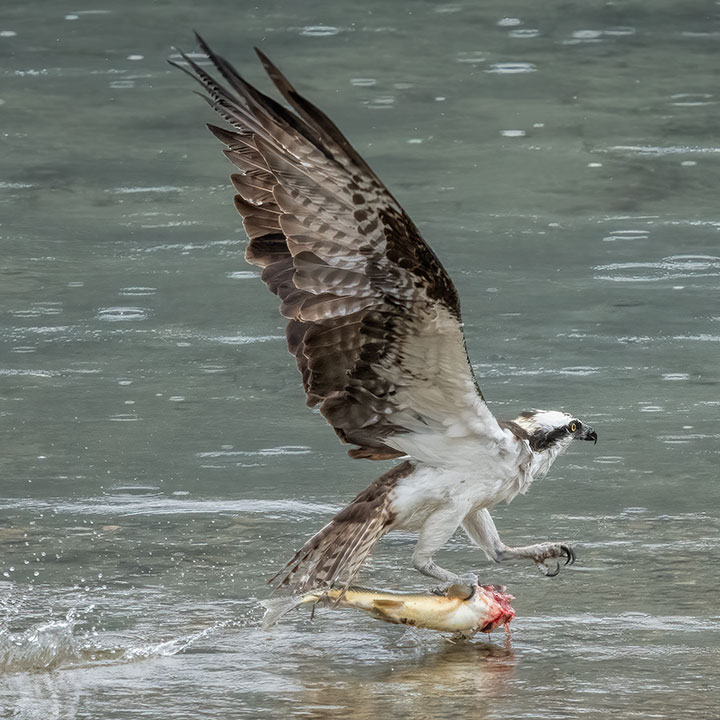Wooden pilings are used by a few species for breeding. Now that these pilings are on their way out, how will this change? Metal pilings are the new standard.
This is the second of a two part series on wooden pilings. The first was on perchers. This one is on breeders. There are only a few birds that have adopted this fairly recent (and short-lived) innovation for their their breeding, but some have adopted it to the near exclusion of other places. No longer content with trees near the water, they now use wooden pilings that sit in Kootenay Lake. In perhaps a half century, some will need to return to the forest. It is noted that these nesters are also perchers.
The dominant birds using the wooden pilings for breeding are the Osprey, the Northern Flicker, and, to a lesser extent, the Tree Swallow. A few others use them occasionally (e.g., Starling). Of all of these, the Osprey seems most assured of some continuity.
The Northern Flicker is a permanent resident, although their numbers do go up during the migration of other flickers north and south. This flicker is a woodpecker which digs cavities in the wooden pilings in which it, and others, nest. It was noted earlier that nearly all the cavities face the land, presumably as a mechanism to enable it to watch for land predators. This is a tactic that does not seem to have an analogue among flickers that breed on land, so how it was quickly adopted when our flickers chose wooden pilings is unclear. Almost every wooden piling on the lake has at least one flicker cavity.
The Northern Flicker has excavated many nest cavities in the wooden pilings around this lake. Here, a father is seen feeding ant’s eggs to its chick. Although carved by flickers, the cavities are extensively used by other birds such as the Tree Swallow.

While a few other birds use flicker cavities, the dominant one seems to be the Tree Swallow. Here a father is bringing food to his chicks, each of which has its mouth open to accept it. However, since the Tree Swallow also regularly breeds elsewhere, a loss of wooden pilings is not expected to bother it significantly.

Ospreys are now the dominant breeder on wooden pilings. At earlier times, they chose trees beside the lake, although ones that usually were not quite so precarious as the one shown in this 1887 illustration. In modern times I have only seen a few couples nest in a tree, but now they almost exclusively nest on wooden pilings, dolphins, or special lake-side poles erected for them.

My earliest knowledge of ospreys nesting on wooden pilings comes from Troup. I don’t know when these had been put in, but pictures reveal that they were not there in the mid-1890s and were in place in 1929. In the mid-1940s, I summered right across the lake from Troup and I recall my uncle talking (in dismay) about someone setting the pilings on fire so as to kill the birds nesting on them. Apparently the arsonist’s logic was that the ospreys caught and ate fish, and, not liking the competition, he wanted to catch those fish for himself. Apart from the cruelty involved, his logic was flawed in that ospreys do not generally catch the same fish as those preferred by people. These pilings still show the signs of having been burnt (photo from 2005). However, it is clear that, by the 1940s, ospreys were building nests on the fairly newly established pilings.

I don’t know when Ospreys began to build nests on dolphins (as distinct fr0m on isolated pilings), but it was probably in the 1960s. In the early 1970s, the number of Ospreys around Kootenay Lake began to increase, and many of these magnificent birds chose the dolphins as a nesting site. Now, an Osprey nest is a rather substantial structure, and when built at the top of a dolphin, it engulfed the light rendering it useless. Although at first the government would remove the nest to reveal the light, they soon changed tactics. They accepted a suggestion by Bob Denison that platforms be added above the light. Since his summer cottage was at Atbara (at the Nine-mile narrows), the dolphin there was the first to have this addition (which he put up himself). These platforms now characterize all dolphins and most play host to Osprey nests and Ospreys. This is the platform on the top of the Nine-mile dolphin at Atbara. Indeed, this practice of building a nesting place for the osprey has gone further than dolphins now. The power company and also private individuals have erected nesting platforms on poles placed near the lake which the ospreys have used.

While I found I do not have a satisfactory shot of a constructed nest platform installed solely for the osprey, I do have a shot of two (full sized) chicks that had just flown from one while their parent watched from above. We can tell these are chicks because of their orangish eyes and their white-flecked wings.

The osprey’s preference for nests on or beside the lake is driven by its food: it catches fish. 
This view of a nest on a wooden piling is of the father osprey bringing a fish to his family. There are three chicks (white spotted wings) and his partner (plain brown wings). When the wooden pilings vanish, the osprey will be likely be fine; it will still have trees and erected platforms on pilings and the dolphins, all in or close to the water.

An advantage of the wooden pilings is that they are out in the water and so free from land predators. This, of course, changes when Kootenay Lake water levels are low during the spring, but then that is not the nesting period. I have assumed that the main land predators of concern would be raccoons. But the squirrel is the only land predator I have thus far seen attacking a nest cavity. In fact, wooden pilings have been a particularly safe place for a nest cavity. Metal pilings will certainly bring advantages to people, but the safe perch and nest will be lost.

As a digression, I note that I have not covered all of the nesters to be found on a wooden piling. There are others. Consider this deer fly laying eggs on a piling. Deer flies were seen laying near the same spot on two separate years. 
The eventual loss of the wooden pilings will be a disappointment for the ardent nature observer, but the animals will adjust. Probably the greatest loser will be the Northern Flicker who found a largely predator-free place to nest. So here is another shot, this one of the mother feeding its two chicks.


What a wonderful history of nesting on pilings! I think that most Kootenay lake dwellers of the human kind watch the pilings for signs of osprey. And some great photos, too.
Thanks, Alllistair!
Thanks so much for a pair of remarkable piling posts. The deerfly was bonus. What a pair of eyes! I wonder if the flicker will find the eggs and keep the deerfly population down.
A mini magnus opus of nature photography and writing, and what more exciting time to enjoy it than during this bountiful blush of Spring. Thank you Alistair!
Wonderful background and stories, as usual. Thank you, Alistair!
In addition to the photos, of course!